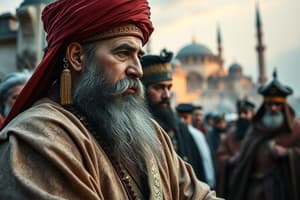Podcast
Questions and Answers
What was the primary consequence of the Battle of Chaldiran in 1514?
What was the primary consequence of the Battle of Chaldiran in 1514?
- The establishment of Shi'a Islam as the state religion of the Ottoman Empire.
- The definitive setting of the border between the Ottoman and Safavid empires, which remains the border between Iran and Iraq today. (correct)
- Isma'il's conversion to Sunni Islam.
- The complete annihilation of the Safavid Empire.
Isma'il, after seizing most of what is now Iran, adopted the title of caliph to signify his religious authority.
Isma'il, after seizing most of what is now Iran, adopted the title of caliph to signify his religious authority.
False (B)
Match each leader with their corresponding actions or outcomes:
Match each leader with their corresponding actions or outcomes:
Isma'il = Seized most of modern-day Iran and established Shi'a Islam as the state religion; became a religious tyrant. Selim the Grim = Ordered the execution of thousands of Shi'a Muslims in the Ottoman Empire after the Battle of Chaldiran. Tahmasp = Expanded the Safavid Empire and adopted the use of artillery in the military.
What was one significant linguistic impact following the Safavid Empire's conversion to Islam?
What was one significant linguistic impact following the Safavid Empire's conversion to Islam?
The Safavids primarily concentrated on diplomacy rather than military strength to protect their empire.
The Safavids primarily concentrated on diplomacy rather than military strength to protect their empire.
Besides language, name two results of cultural blending.
Besides language, name two results of cultural blending.
The Safavids aligned themselves with the ______ branch of Islam.
The Safavids aligned themselves with the ______ branch of Islam.
Chinese artistic elements were found in which of the following within the Safavid Empire?
Chinese artistic elements were found in which of the following within the Safavid Empire?
Which fundamental aspect of societal progression significantly propelled the Safavid Empire's advancement, intertwining territorial expansion with continuous cultural interchange?
Which fundamental aspect of societal progression significantly propelled the Safavid Empire's advancement, intertwining territorial expansion with continuous cultural interchange?
What is the most accurate definition of cultural blending?
What is the most accurate definition of cultural blending?
Cultural blending typically occurs in isolated regions with limited contact with other cultures.
Cultural blending typically occurs in isolated regions with limited contact with other cultures.
Which empire provides a strong example of cultural blending and ruled Persia between the 16th and 18th centuries?
Which empire provides a strong example of cultural blending and ruled Persia between the 16th and 18th centuries?
Societies resistant to change are more likely to benefit from cultural blending.
Societies resistant to change are more likely to benefit from cultural blending.
Suleyman's court was notable for:
Suleyman's court was notable for:
What critical military adaptation did Tahmasp implement based on the Safavid's defeat at Chaldiran?
What critical military adaptation did Tahmasp implement based on the Safavid's defeat at Chaldiran?
How did Isma'il's religious policies impact the demographics of Baghdad?
How did Isma'il's religious policies impact the demographics of Baghdad?
How did Tahmasp's territorial expansion shape the Safavid Empire's demographics and cultural diversity?
How did Tahmasp's territorial expansion shape the Safavid Empire's demographics and cultural diversity?
Which of the following scenarios is most likely to foster cultural blending?
Which of the following scenarios is most likely to foster cultural blending?
How did Suleyman contribute to cultural blending in the Ottoman court?
How did Suleyman contribute to cultural blending in the Ottoman court?
Which factor would most likely not inhibit cultural blending within a society?
Which factor would most likely not inhibit cultural blending within a society?
In the context of cultural blending, what role do trade routes typically play?
In the context of cultural blending, what role do trade routes typically play?
Which statement accurately reflects a condition conducive to cultural blending?
Which statement accurately reflects a condition conducive to cultural blending?
How did the Ottomans' location on a major trading route contribute to cultural blending?
How did the Ottomans' location on a major trading route contribute to cultural blending?
What is the relationship between cultural blending and societal adaptation?
What is the relationship between cultural blending and societal adaptation?
Which action taken by the Safavids demonstrates their strategic prioritization to defend against neighboring empires?
Which action taken by the Safavids demonstrates their strategic prioritization to defend against neighboring empires?
Flashcards
Cultural Blending
Cultural Blending
The process where different cultures influence and combine with each other.
Safavid Empire
Safavid Empire
A Shi’ite Muslim dynasty that ruled Persia from the 16th to 18th centuries, known for cultural blending.
Causes of Cultural Blending
Causes of Cultural Blending
Factors that lead to the mixing of cultures, including migration, trade, religious reasons, and conquest.
Migration
Migration
Signup and view all the flashcards
Pursuit of Religious Freedom
Pursuit of Religious Freedom
Signup and view all the flashcards
Trade
Trade
Signup and view all the flashcards
Conquest
Conquest
Signup and view all the flashcards
Suleyman the Magnificent
Suleyman the Magnificent
Signup and view all the flashcards
Isma’il
Isma’il
Signup and view all the flashcards
Shi’a Islam
Shi’a Islam
Signup and view all the flashcards
Battle of Chaldiran
Battle of Chaldiran
Signup and view all the flashcards
Tahmasp
Tahmasp
Signup and view all the flashcards
Safavid Empire's Golden Age
Safavid Empire's Golden Age
Signup and view all the flashcards
Persian Language
Persian Language
Signup and view all the flashcards
Democratic Government
Democratic Government
Signup and view all the flashcards
Mestizo
Mestizo
Signup and view all the flashcards
Art and Architecture in Safavid Empire
Art and Architecture in Safavid Empire
Signup and view all the flashcards
Isma'il
Isma'il
Signup and view all the flashcards
Safavid Military
Safavid Military
Signup and view all the flashcards
Shi'a Islam
Shi'a Islam
Signup and view all the flashcards
Religious Freedom
Religious Freedom
Signup and view all the flashcards
Ottoman Empire
Ottoman Empire
Signup and view all the flashcards
Isma’il's title
Isma’il's title
Signup and view all the flashcards
Religious Tyranny
Religious Tyranny
Signup and view all the flashcards
Outcome of Chaldiran
Outcome of Chaldiran
Signup and view all the flashcards
Tahmasp's military strategy
Tahmasp's military strategy
Signup and view all the flashcards
Golden Age of Safavids
Golden Age of Safavids
Signup and view all the flashcards
Cultural Blending Results
Cultural Blending Results
Signup and view all the flashcards
Persian Language Evolution
Persian Language Evolution
Signup and view all the flashcards
Democratic Government Spread
Democratic Government Spread
Signup and view all the flashcards
Racial Blending Example
Racial Blending Example
Signup and view all the flashcards
Art and Architecture Influence
Art and Architecture Influence
Signup and view all the flashcards
Shi’a Branch of Islam
Shi’a Branch of Islam
Signup and view all the flashcards
Safavid Military Development
Safavid Military Development
Signup and view all the flashcards
Conquest and Interaction
Conquest and Interaction
Signup and view all the flashcards
Study Notes
Cultural Blending
- Different cultures have interacted throughout history
- They influence and blend with each other
- The Safavid Empire (16th-18th centuries) demonstrates a blending of cultural traditions
- Interactions among people create cultural blends
- Continental crossroads, trade routes, ports, and borders of countries are common sites for cultural blending.
- Cultures interact by being exposed to new ideas, technologies, foods, and unique ways of life
- Societies that easily adapt and are open to new ways, benefit from cultural blending.
Causes of Cultural Blending
- Migration: People moving to new areas bring their culture
- Pursuit of Religious Freedom or Conversion: Motivates people to spread their beliefs and cultures (Example: Turks seeking territory and converts to their Muslim religion).
- Trade: Exchange of goods, ideas, and technology through trade routes (Example: Ottoman Empire's location on a major trading route)
- Conquest: Conquered cultures impose their culture on others
Results of Cultural Blending
- Language changes incorporate words from other cultures (Example: Arabic words appear in the Persian language)
- Religious and ethical systems become mixed
- Government styles change to blend with the existing systems (Example: Various democratic government principles across cultures);
- Races and ethnicities mix creating new groups (Example: mestizos, people of mixed European and Indian ancestry in Mexico).
- Arts and architecture merge with ideas and designs from different cultures (Example: Chinese artistic elements in Safavid Empire tiles and carpets)
- Examples include the creation of mestizo culture in Mexico through Spanish and Aztec interactions
Safavid Empire
- The Safavids were members of an Islamic brotherhood
- Aligned themselves with the Shi'a tradition
- Their military expanded the empire under Isma'il (12 years old) in Persia
- The conquest of Persia by Ismail had a decisive outcome, defining Persia as a Shi'ite nation, replacing the Sunni Sultanate of Delhi.
- Isma'il also established Shi'a Islam as the state religion to celebrate the achievement
- Isma'il was a religious tyrant who killed non-Shi'ite people
- The battle of Chaldiran in 1514 defeated their forces and set the border between the Ottoman and Safavid Empires (Example: 40,000 deaths during this battle).
- Tahmasp, Isma'il's son continued the expansion of the Safavid empire into the Caucasus Mountains, bringing Christians under Safavid rule (Example: Tahmasp adopted the use of artillery).
Studying That Suits You
Use AI to generate personalized quizzes and flashcards to suit your learning preferences.


